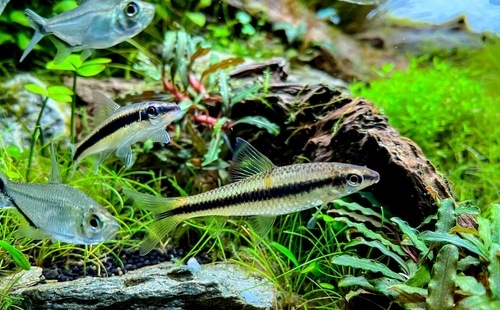Looking for the best Siamese Algae Eater tank mates? We’ve got the fish for you!
The best Siamese Algae Eater Tank mates are fish that can handle roughly the same size of tank and water parameters as the Siamese algae eater. Those fish should also be able to stay compatible with the algae eater’s temperament without unnecessary aggression or stress.
In this article we’ll go over what makes the best Siamese algae eater tank mates. We’ll check out each of the fish species on our list to show off why you might want to pick them for your tank, and we’ll go over why they make great companions for Siamese Algae Eaters, specifically. Let’s get started!
Contents
Siamese Algae Eater Tank Mates – What You Need to Know
Having fish is a lot of work. In addition to giving the best care to your Siamese algae eater, you’ll need to know what makes each potential tank mate tick, too. We’ve provided an overview of that information in the sections below:
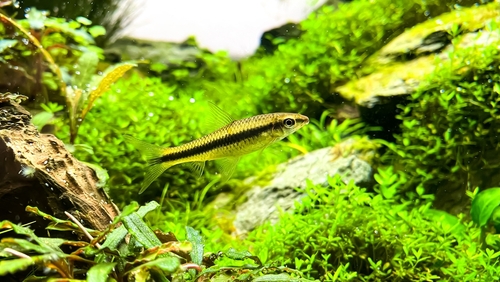
Temperament
Temperament in a fish with tank mates is even more important than matching temperaments for human roommates would be. If fish don’t get along because of conflicting temperaments, the fish with the more peaceful personality could become sick from stress, lose its appetite and even die.
The way to prevent this is to know the temperaments and what works best between each fish in your tank. For example, the Siamese algae eater is a peaceful fish. It can be long and might look intimidating to smaller fish, but it really would not injure any of it’s neighbors.
Fish that are more aggressive and likely to keep bothering or bullying the Siamese Algae eater won’t work as tank mates. Pick other peaceful, relaxed fish for the best results!
Size
A Siamese Algae Eater usually grows up to 6 inches in length, making it more of a medium-sized fish. It will need fish that are not too much smaller than itself in order to avoid fights or chases. You don’t want one fish thinking the other is their next meal!
Additionally, don’t get any fish that are too much larger than your Siamese Algae Eater for the same reason.
Competition
Competing can happen between fish when they both eat the same types of food. Timing is also a factor. If your tank mates all eat at the same time, there is a high likelihood that the slower fish won’t get their fair share.
What you need for the Siamese Algae Eater are fish that do not eat the same foods or tend to eat in different time periods throughout the day. In fact, even simply having fish that eat in different zones than the Siamese Algae Eater is a great idea.
Parameters & Tank Setup
A Siamese Algae Eater is, as previously mentioned, not a small fish in terms of aquariums. With a Siamese Algae Eater by itself, you need at least 30 gallons of water; add more for every inch of fish you are adding to the tank in terms of tank mates.
Siamese Algae Eaters may be bottom to mid-dwellers, but that does not mean they don’t like to explore. Find rocks and plants that they can enjoy swimming around in the tank. They also need a temperature range of 75 to 79 degrees Fahrenheit.
With fish that have similar desires and needs in their environment, you’ll have a healthy and happy community tank.
Best Siamese Algae Eater Tank Mates
- Bronze Cory
- Guppy
- Amano Shrimp
- Apple Snail
- Rosy Barb
- Neon Tetra
- Honey Gourami
- Tiger Barb
Let’s look at all of these Siamese Algae Eater tank Mates more closely and see why they meet the necessary standards.
You will also like these other popular posts in this category:
1. Bronze Cory

- Scientific Name: Corydoras aeneus
- Adult Size: 2 inches
- Compatible With: Siamese Algae Eaters
- Care Level: Easy
- Origin: Colombia, Argentina, Venezuela
Bronze cories are also sometimes called green cories depending on the tint of their dull coloration. However, don’t let their brown-to-beige, or even green, colors dissuade you from getting one of these fish! Bronze cories are awesome because they have a very chill, peaceful lifestyle, and if you get a group of them, they can be a very active, fun fish for your aquarium.
They tend to stay on the bottom of the tank, cleaning up after their tank mates. They cause no trouble, but they can take care of themselves if threatened.
Pros of keeping with Siamese Algae Eater:
- No aggression
- No food competition
- Cleans up bottom of the tank
Cons of keeping with Siamese Algae Eater :
- None
2. Guppy
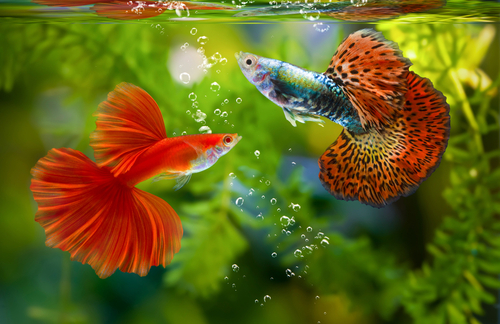
- Scientific Name: Poecilia reticulata
- Adult Size: 2 inches
- Compatible With: Siamese Algae Eaters
- Care Level: Easy
- Origin: South America
Guppies come in all colors and patterns, though speckles are most common. They are usually more vibrant in the males of the species, but no guppy could be called ugly or dull. Guppies can have long tails or short, round ones. They come in an array of colors and fin shapes and are one of the easiest fish in the hobby to breed. So don’t be surprised if you start seeing little baby guppies popping up after a while!
Regardless of which fancy-looking guppy you choose, you won’t be disappointed with it’s compatibility to the Siamese Algae Eater. This fish is gentle and gets along well with others.
Pros of keeping with Siamese Algae Eater:
- No aggression
- No food competition
Cons of keeping with Siamese Algae Eater:
- None
3. Amano Shrimp
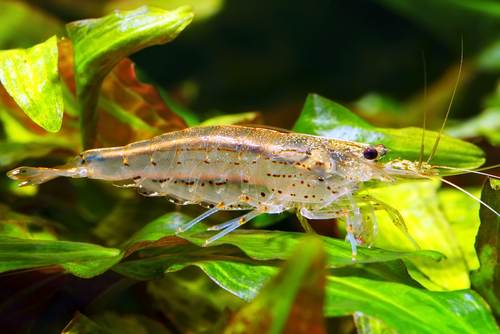
- Scientific Name: Caridina multidentata
- Adult Size: 2 inches
- Compatible With: Siamese Algae Eaters
- Care Level: Easy
- Origin: Japan
Taking a break from our fishy friends, one of the best companions to a Siamese Algae Eater is actually a shrimp! Amano shrimp are small, and sometimes called by different names like “Japonica Amano Shrimp,” or “Japanese Swamp Shrimp.”
Amano shrimp are named after the famous aquarist Takashi Amano who was known to use them in many of his planted aquariums. They are very popular with aquarists because they are easy to care for and eat unwanted algae in the tank. As long as you have plants for them to dwell in, Amano shrimp clean up detritus and bother nobody.
Pros of keeping with Siamese Algae Eater:
- No aggression
- No food competition
- Cleans up bottom of the tank
Cons of keeping with Siamese Algae Eater :
- None
4. Apple Snail

- Scientific Name: Pomacea Cuprina
- Adult Size: 2 inches
- Compatible With: Siamese Algae Eaters
- Care Level: Easy
- Origin: Amazon, Florida, Hawaii, Southwest Asia
The apple snail is another great break from fish tank mates for the Siamese Algae Eater. It comes in very many different colors, not just in shells but in the snail’s body. They are omnivorous. This means that while the Siamese Algae Eater is cleaning up algae, the apple snail is taking care of other fish leftovers!
Apple snails won’t be any threat to your Siamese Algae Eater’s peace of mind. That said, you may not want to keep more than one apple snail, because they do tend to multiply quickly.
Pros of keeping with Siamese Algae Eater:
- No aggression
- No food competition
- Cleans up the bottom of the tank
Cons of keeping with Siamese Algae Eater :
- None!
5. Rosy Barb
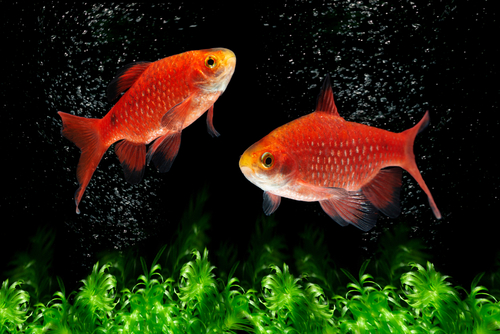
- Scientific Name: Puntius conchonius
- Adult Size: 6 inches
- Compatible With: Siamese Algae Eaters
- Care Level: Easy
- Origin: India, Bengal
Rosy Barbs, otherwise known as red barbs, look a little like rockstars. This is thanks to their bright orange, red, and gold coloring, as well as their mohawk-like fins. Rosy barbs may be small, but what they lack in size they make up for in energy!
Rosy barbs like to play tag with members of their own species. They enjoy flitting in and out of plants, having the time of their lives, and keeping you entertained! That said, they aren’t aggressive and won’t bother your Siamese Algae Eater.
Pros of keeping with Siamese Algae Eater:
- No aggression
- No food competition
- Fun to watch
Cons of keeping with Siamese Algae Eater :
- None
6. Neon Tetra

- Scientific Name: Paracheirodon innesi
- Adult Size: 1 inch
- Compatible With: Siamese Algae Eaters
- Care Level: Easy
- Origin: Peru, Western Brazil, Southeastern Colombia
Neon tetras are named for their colors. The front half of their bellies are a shimmery white color, while most of their tails are red. Their backs and sides are striped with a very reflective, flashy electric blue. A school of these brightly colored fish swimming in an aquarium are always stunning!
This electric blue color earned neon tetras their title and will make a great contrast with the Siamese Algae Eater. Neon tetras are peaceful, as long as they have three or four of their own kind to help keep them confident and happy.
Pros of keeping with Siamese Algae Eater:
- No food competition
- No aggression
Cons of keeping with Siamese Algae Eater :
- None!
7. Honey Gourami
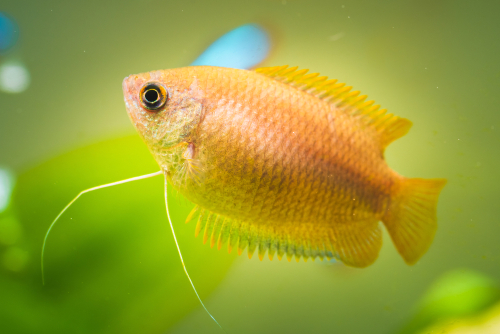
- Scientific Name: trichogaster chuna
- Adult Size: 2 inches
- Compatible With: Siamese Algae Eaters
- Care Level: Easy
- Origin: Bangladesh, India
Honey Gouramis may look beautiful, like little gold coins coming to life and swimming around your tank. However, did you know that in the wild they are adept marksmen? When a honey gourami hunts, it spits water at flying bugs. These bugs are knocked into the water, where honey gouramis are waiting to feast!
Honey gouramis in captivity are a little less lethal, especially to other fish! They are peaceful, like to swim in groups of their own kind, and won’t cause any stress to your Siamese Algae Eater.
Pros of keeping with Siamese Algae Eater:
- No aggression
- No food competition
Cons of keeping with Siamese Algae Eater :
- None
8. Tiger Barb
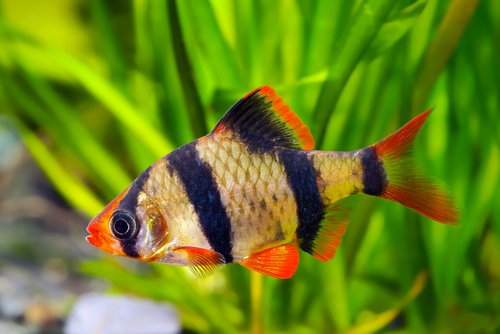
- Scientific Name: Barbus tetrazona
- Adult Size: 3 inches
- Compatible With: Siamese Algae Eaters
- Care Level: Easy
- Origin: Sumatra, Borneo, Indonesia
Tiger barbs are also called Partbelt barbs or Sumatra barbs. With their gold bodies and bold black stripes, it’s no wonder they are called Tiger barbs. Combine their tiger pattern with beautiful blood-red fins, and it’s no surprise they are among the most popular fish for aquarium owners to purchase. They are remarkably easy to care for, and they get along very easily with many other species of fish in the right conditions.
A tiger barb is relatively peaceful, but if tiger barbs feel isolated or don’t have enough room, they are prone to nipping; this is especially true of fish that have long, trailing fins like angelfish. Your Siamese Algae Eater should be fine, but it is worth noting if you have a community tank!
Pros of keeping with Siamese Algae Eater:
- No aggression
- No food competition
Cons of keeping with Siamese Algae Eater :
- None!
In Conclusion
To sum it all up, Siamese Algae eater tank mates should be fish that can coexist with the algae eater in terms of a peaceful temperament, an ability to keep to their own space, and the same water needs.
These fish could be smaller varieties, like tetras and danios, or they could simply be bottom-dwellers like bronze cories! Either way, with good tank mates, you’ll have a vibrant and varied tank in no time.

JJ has had a passion for learning about aquatic life since age 5. As an adult, he made his passion a career as a certified aquaculture dealer and aquarium content creator.


